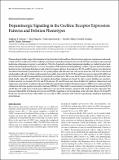Dopaminergic Signaling in the Cochlea: Receptor Expression Patterns and Deletion Phenotypes
Author(s)
Maison, Stephane F.; Liu, Xiao-Ping; Eatock, Ruth Anne; Sibley, David R.; Grandy, David K.; Liberman, M. Charles; ... Show more Show less
DownloadMaison-2012-Dopaminergic Signali.pdf (2.461Mb)
PUBLISHER_POLICY
Publisher Policy
Article is made available in accordance with the publisher's policy and may be subject to US copyright law. Please refer to the publisher's site for terms of use.
Terms of use
Metadata
Show full item recordAbstract
Pharmacological studies suggest that dopamine release from lateral olivocochlear efferent neurons suppresses spontaneous and sound-evoked activity in cochlear nerve fibers and helps control noise-induced excitotoxicity; however, the literature on cochlear expression and localization of dopamine receptors is contradictory. To better characterize cochlear dopaminergic signaling, we studied receptor localization using immunohistochemistry or reverse transcriptase PCR and assessed histopathology, cochlear responses and olivocochlear function in mice with targeted deletion of each of the five receptor subtypes. In normal ears, D1, D2, and D5 receptors were detected in microdissected immature (postnatal days 10–13) spiral ganglion cells and outer hair cells but not inner hair cells. D4 was detected in spiral ganglion cells only. In whole cochlea samples from adults, transcripts for D1, D2, D4, and D5 were present, whereas D3 mRNA was never detected. D1 and D2 immunolabeling was localized to cochlear nerve fibers, near the first nodes of Ranvier (D2) and in the inner spiral bundle region (D1 and D2) where presynaptic olivocochlear terminals are found. No other receptor labeling was consistent. Cochlear function was normal in D3, D4, and D5 knock-outs. D1 and D2 knock-outs showed slight, but significant enhancement and suppression, respectively, of cochlear responses, both in the neural output [auditory brainstem response (ABR) wave 1] and in outer hair cell function [distortion product otoacoustic emissions (DPOAEs)]. Vulnerability to acoustic injury was significantly increased in D2, D4 and D5 lines: D1 could not be tested, and no differences were seen in D3 mutants, consistent with a lack of receptor expression. The increased vulnerability in D2 knock-outs was seen in DPOAEs, suggesting a role for dopamine in the outer hair cell area. In D4 and D5 knock-outs, the increased noise vulnerability was seen only in ABRs, consistent with a role for dopaminergic signaling in minimizing neural damage.
Date issued
2012-01Department
Harvard University--MIT Division of Health Sciences and TechnologyJournal
Journal of Neuroscience
Publisher
Society for Neuroscience
Citation
Maison, S. F. et al. “Dopaminergic Signaling in the Cochlea: Receptor Expression Patterns and Deletion Phenotypes.” Journal of Neuroscience 32.1 (2012): 344–355.
Version: Final published version
ISSN
0270-6474
1529-2401